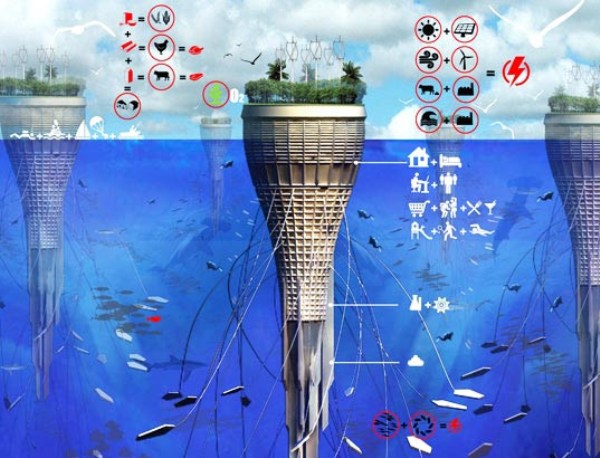
Today:
Skyscrapers – the very word initiates that flashing reverie of a ‘forest’ of glistening glass-concrete towers, tall and mighty in their imposing forms. But the truth of the matter is skyscrapers are conceived primarily as tools of economy and urban design. These vertical behemoths provide us with a much higher ratio of rentable floor space per unit area of land in comparison to horizontally expansive structures. And in their final embodiment, these skyscrapers tend to define and rather enliven the particular skyline of a city, be it New York or Hong Kong. But again the amount of resources and energy expended to build such structures is huge both in magnitude as well as scope. Moreover, additional energy is wasted for creating stronger foundations and lifting building materials to the very top during the construction stage, not to speak of the heavy machines and the labor involved.
Tomorrow:
The future is diffused with progressive and credible proposals for the majority of the human population that aims to move onto self-sufficient, floating ‘island-cities’. This can be a direct result of the adverse effects of global warming, like rising sea levels affecting our land eco-system and engulfing our major coastal cities.
One such enlightened, yet advanced proposition by Sarly Adre Bin Sarkum, is the Underwater-Scraper, which is imbued with the conscientious dictum of clean energy generation and sustainable food production. It’s a fascinating conception of eco-architecture that is reliant on variant degrees of green, sustainable technologies.
The Inspiration:
Instigation (inspiration rather) has been instrumental in putting forth this revolutionary concept. As mentioned above, the increased sea levels emanating from global warming might one day severely alter our urban settlement patterns, especially affecting our coastal cities. So, this concept would technologically make use of under-ocean living conditions. ‘Rapture‘ anyone?
Eco-credentials:
Sustainable, green technology is the key phrase in this wondrous design. Not only will it act as a refuge in a post-apocalyptic scenario, but it is also touted to produce its very own clean electricity by harnessing the abundant wave energy as well as wind and solar power. Again the city being kept upright by a system of ballasts will have hanging tethers for producing kinetic energy! Agriculturally, it will produce its own self-sufficient food by using farming, aquaculture and hydroponics. The top surface of the city will house a vibrant forest nourished by the beaming sun, while the lower levels will contain the working and living quarters for people.
The Hurdles:
1. Sea Storms:
Naturally this can be the severest hurdle in the face of this design.
2. Transportation:
A whole new transit system would be required, keeping in mind the total economic situation prevailing then. Furthermore, underwater transportation is not that feasible when compared to land transportation.
3. High Humidity:
The humidity levels would be much higher under water. Moreover there is no definite solution for cramped spaces in case of population increase.
4. High Cost:
The same problem plaguing the ‘over-water’ skyscrapers; the cost involved could be huge even if we possess the technology.
Is it feasible?
Well, it could take years to complete and demand a very high expenditure. The architects need to suggest solutions to psychological problems like living in confined spaces without natural lighting and structural problems like weathering of sea storms as well. Nevertheless, we cannot deny the novelty of this design which aims to make total usage of green, emission free technology, and at the same time provide us with a shelter from the repugnant effects of global warming.




